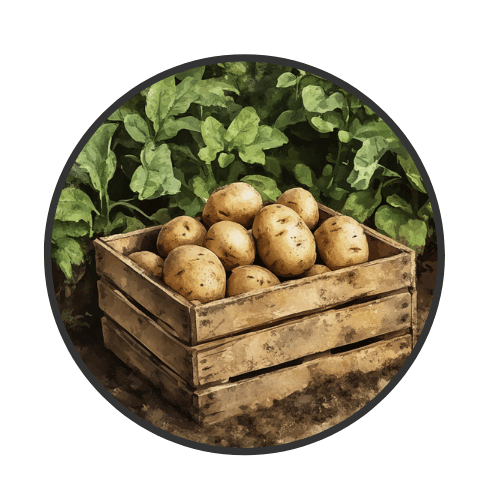The idea of growing your own potatoes may seem counterintuitive at first. After all, they are so affordable to buy! That is true, but until you branch out and begin exploring the wide, wonderful world of potatoes, you may not know that there are so many delicious varieties that you won't find in the grocery store. So knowing how to grow your own potatoes can vastly expand your potato-gastronomy experience.
The first step is to pick your own exciting variety to grow. Look online or at your local nursery. Grocery store potatoes have been radiated, so they won't work. There are three main growing types: Early, second early, or crop potatoes. Early potatoes are great in salads or with fresh mint or other herbs from your garden. These are sweeter but don't store as well as later varieties. Second early potatoes come in about two weeks later. They are a little larger. The crop potatoes are your late-summer potatoes that will last well into the winter when harvested and stored right, so you can continue to enjoy the fruits of your labor well into the winter as your garden sleeps.
Keep in mind, this is a general guide, and you will need to adjust your planting, and care will vary depending on your soil and planting zone. There are more and more options these days - you can grow potatoes in a container, in-ground in piles, and there are even bags now that have easy-harvest abilities. If you're limited on space, you can start in-ground and add boards to support hilling soil to grow vertically. However, if you want an abundant supply, rows are the best option.
You can start your crop when the soil begins to warm. Follow the guidelines provided by the seed potato provider. Keep your starts cool and dry and in open space with room to let air move around each one. After they start to grow little white/green bumps, they are ready to go. If you have large seed potatoes, you can cut them into parts. Make sure and have at least two eyes per cut piece and let the cut edge dry. Store in a cool, dark place for 24 hours before you put them in the ground. Place them in your row 18 inches apart. Cover loosely with aged compost and soil. Give it a proper watering, and you are up and running! Now care for your plants and watch for them to grow. When you see the green growth coming up from the ground, you need to stay diligent and be ready to top off the mounds or rows. Have good soil and aged compost at the ready. When you have 6-inch greens, gently mound up your soil right onto the greens. They will continue to grow, and you can repeat this to increase your crop as long as the type of potato and your growing climate will allow.
Now the most fun part of the season: harvesting and eating! For the firsts and second firsts, you will want to start harvesting them two months or so from planting, but watch for your plant to tell you when it is ready. When you see one flower, it's time to harvest that individual plant. This is not time to collect all the plants, watch for each one to tell you. On a dry day soon after they flower, loosen the soil around the area with a fork to release. Cut the tubers away from the plant and let air dry. Anything you cut through the skin needs to go into the "eat now" pile. It will not store well. Put the rest on some dry newspaper and keep in a dark, dry place.
The process is the same for your main crop potatoes, but they should be closer to the end of the season, and you may see the flowering and green tops die off at the same time. This is fine as long as your soil is not staying wet for many days.
I really encourage you to try and grow a crop, even a tiny bag on your patio. Homegrown is sweeter in so many ways. And don't give up if you fail, try again!







Leave a comment
All comments are moderated before being published.
This site is protected by hCaptcha and the hCaptcha Privacy Policy and Terms of Service apply.